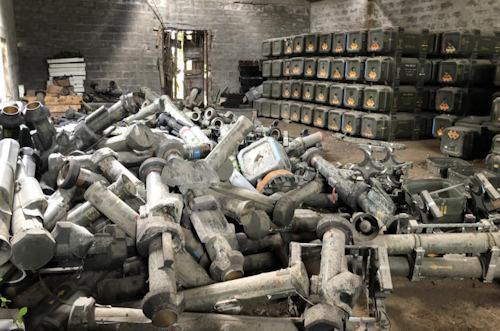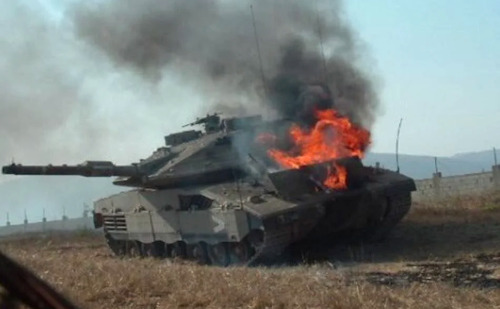The Ukrainian infantry, as part of the anti-tank fight, is applying the tactics developed by the German infantry during the last phases of the Second World War, as well as to stem a hypothetical Soviet invasion of the plains of West Germany (Fulda Pass) during the war Cold.
In this regard, the territorial, planned to operate on foot or aboard wheeled and tracked vehicles (Wiesel - photo) armed with MILAN and TOW missiles. The problem with these anti-tank systems is that they are heavy and require the operator to stay on target for the entire flight time of the missile, inevitably exposing it to reaction fire.
In order to have a more effective and at the same time more transportable armament, in the mid-80s of the last century, c / c rocket launchers appeared among the infantry ranks of the Alliance rocket launcher capable of destroying even MBTs, for the time, more protected than the Warsaw Pact.
The rocket propulsion allowed a decent range (400-500 m), it did not require a heavy launcher, as the propellant, at the start, vented its energy to the rear (in the open part of the launcher), however limiting its use in the environments closed.
 Precisely the entry into service of the new Soviet MBTs (T-64B, T-72A and T-80U), which used reactive armor (tiles containing explosives that are activated once hit by HEAT charges) to implement the protection , made it necessary to adopt "heavy" counter-tank rocket launchers, such as the German Panzerfaust 3 (photo), English LAW-80 and the French Apilas.
Precisely the entry into service of the new Soviet MBTs (T-64B, T-72A and T-80U), which used reactive armor (tiles containing explosives that are activated once hit by HEAT charges) to implement the protection , made it necessary to adopt "heavy" counter-tank rocket launchers, such as the German Panzerfaust 3 (photo), English LAW-80 and the French Apilas.
The German rocket launcher is the heir to the "Armored Fist" of the Second World War that inflicted so much damage on Soviet armored units.
Il Panzerfaust 3 has a 110 mm - 125 mm tandem-charged rocket, introduced into service in the Swiss Army in 1995 - capable of drilling over 700 mm of homogeneous steel at 500 meters.
It is not a completely expendable weapon (disposable), as the firing system and aiming optics are preserved.
The Italian Army acquired a large quantity of them in the mid-90s to equip the infantry with an effective short-range anti-tank weapon (they have been widely used in Iraq and Afghanistan for tasks other than their design).
Initially, the general staff was oriented towards theApilas (following photo), in fact he acquired a lot to equip paratroopers and raiders in Somalia, during the operation Ibis..

The French rocket launcher has a caliber of 112 mm and offers the same performance as the bazooka (even in this weapon the aiming organs are removed once the rocket is launched). It was later adopted by Saudi Arabia, Finland, Jordan and South Korea.
The English LAW-80 is a classic “disposable” rocket launcher, with an extendable tube of 94 mm caliber and a mass of 9 kg. Its peculiarity is dictated by the presence of a shot adjustment system consisting of a small 9 mm caliber rifle with 5 shots, having ballistic characteristics that mirror those of the rocket. The operator, thanks to the tracer bullets, can identify the point of impact on the target and launch the rocket at you (a device already in use with the 40 mm M-106 recoilless cannon), obviously maximum effectiveness is obtained with a fixed target, quite another situation would occur with a moving target.
With the entry into service of the most modern missile systems - and therefore lighter and more performing - the use of rocket launchers has decreased, remaining however, being cheaper, in use by various militias in Africa and the Middle East. Hezbollah made extensive use of the Russian RPG-29 rocket launcher during the Second Lebanon War (2006), causing many losses in the Israeli armored corps.
 For the record i Merkava Damaged Mk-4s were recovered (the tank's modular armor can be easily replaced if damaged or replaced entirely with stronger materials if available) and repaired while the crews suffered very little damage.
For the record i Merkava Damaged Mk-4s were recovered (the tank's modular armor can be easily replaced if damaged or replaced entirely with stronger materials if available) and repaired while the crews suffered very little damage.
The 105mm head of the RPG-29, in tandem, is capable of drilling 1.000mm of homogeneous steel 500 meters away.
As previously mentioned, the introduction of new anti-tank missile systems such as the Spike, the Javelins, the NLAW, etc. allows the operator to engage the target and take cover as they are "nature and forget”, In addition they have a double charge with an attack profile from above (ie where the vehicle is less protected).
The "heavy" rocket launchers, therefore, have seen their use decrease in favor of less powerful but lighter models, such as the latest version of the LAW-66 (in particular those produced by the Norwegian NAMMO), or the Swedish AT-4 and the Spanish C-90.
All these c / c systems are used in the Ukrainian conflict and, from the information we receive, are inflicting heavy losses (along with the use of other systems) on Russian tanks.
Photo: Bundeswehr / Italian Army / web












